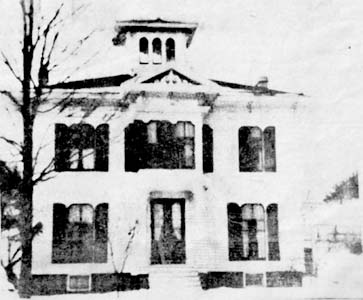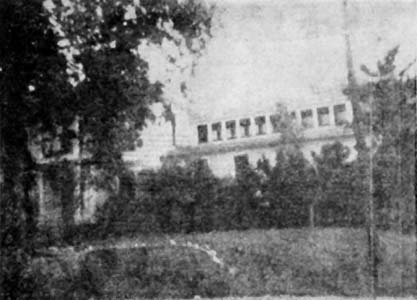[Newspaper]
Publication: The Victor Herald
Victor, NY, United States
vol. 90, no. 36, p. 1, col. 1-4
Progress Dooms
Historic Home
Progress marches on, even at the expense of one of the oldest and more important homes on Victor's Main, Street.
Next to feel the blow of the bulldozer blade is the one hundred year old former Fred M. Locke home at 305 East Main Street. It will be removed in October to make way the new East Victor bridge approach.
The building, which recently housed the Jake Garvey family, was once the home of the inventor of the high tension porcelain insulator and founder of the Victor Insulators Division of I-T-E Circuit Breaker Company, Maple Avenue.
| |||
| OLD LOCKE HOUSE — This photo of what is presently the residence of the Jake Garvey family, was taken around 1900. Shows the house as it looked before the wing containing the laboratory was added by Fred M. Locke, founder of Victor Insulators. |
The 14-room, Victorian Structure had been the scene of the first experimental steps toward boron silica glass (now known as Pyrex); glass fry ovenware, synthetic amethysts and rubies — predecessors of today's man made diamonds and star sapphires. Early photographic efforts in cloud pictures were also processed in a lab in the house.
The house, which was built about 1865, was known as the Clark residence when the Locke family moved in, in 1900. They had formerly lived on Dryer Road according to James Locke, 59 Catherine Street, Canandaigua, one of the three surviving Locke sons. The other two are Morton Locke, West Lake Road and Peer of Rome, New York.
The sons remember playing with their brothers, Louis P. and Fred James in a tree house in the big elm which still stands out front and attending Victor School.
After selling Victor Insulator around 1888 [sic] 1904, Locke Sr. built the large east wing of the house for his laboratory. His later research experiments were performed in it.
| |||
| MORE RECENTLY — the old house looks like this. Photo shows the wing which Fred M. Locke added for a laboratory. This laboratory was the scene of the first experimental steps toward the development of Pyrex used in insulators manufactured by Victor Insulators. House is to be torn down. |
The family moved to Lima in 1909 where Locke's interests in the Lima Insulator Company had become important. The home was finally sold in 1953 to the Garveys by the Locke estate. The Garveys, including Janet, Caren, Conrad and Kevin, have moved to the Hillcrest development in Victor.
Locke came to Victor in 1888, was first a telegraph operator for the Auburn branch of the New York Central Railroad. The whole family was a "telegraph" family. All the boys and their mother, the farmer Mercey Peer of Canandaigua, were proficient in Morse Code. James recalls his mother taking over the telegraph operation, leaving her husband free to work on his kitchen stove experiments.
Nicknamed "Mertensia" because of her inability to spell that station correctly, Mercey Locke died in 1952, surviving her husband by 22 years.
Fred Locke is said to have installed the first electric light and first telephone systems (both of his own making) in Victor at the old Gene Berry mill.

